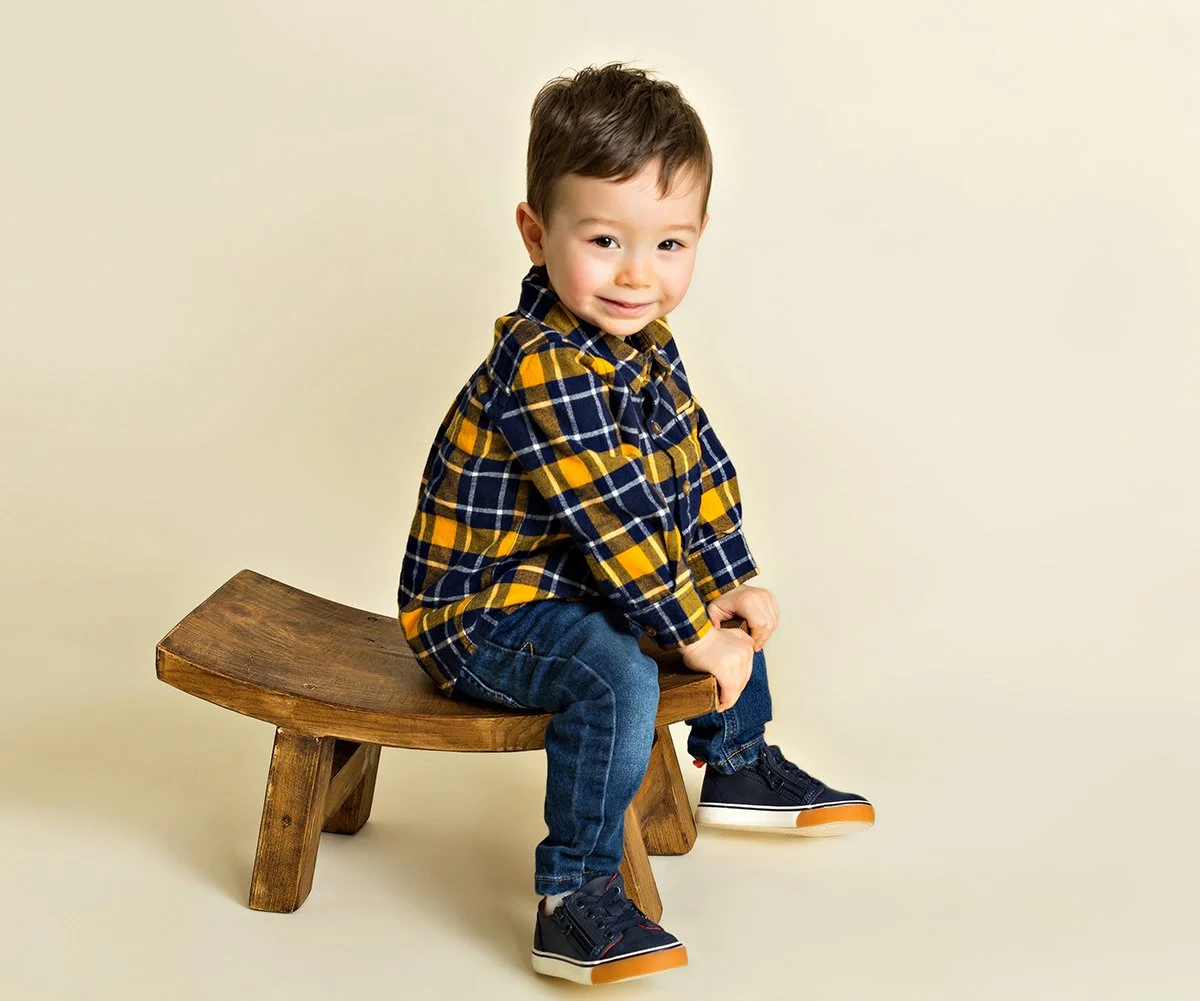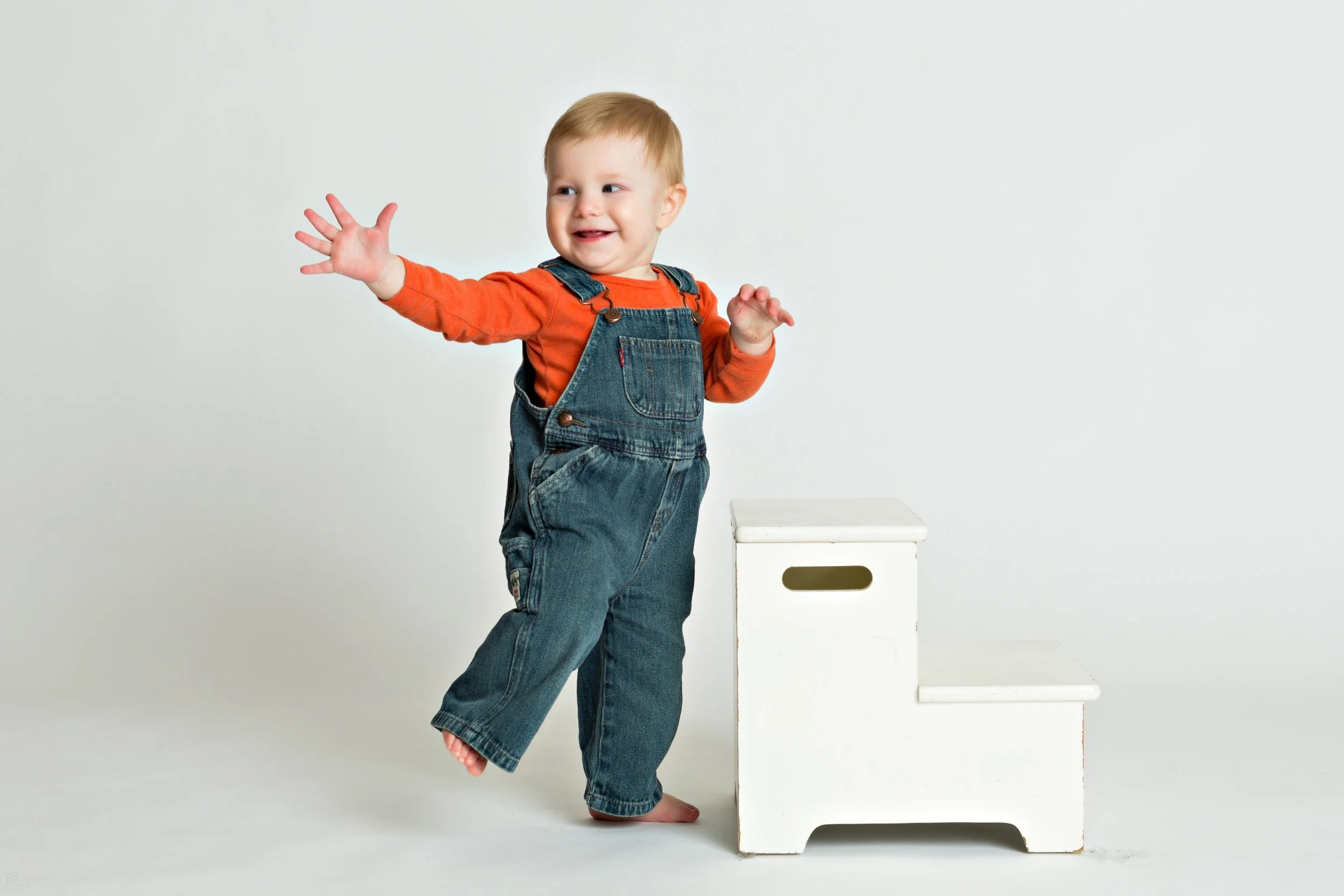Ideas for Posing Toddlers (That Actually Work)
TL;DR
To get natural toddler photos:
Keep it short (10–20 minutes) and schedule around naps/snacks.
Create a “boundary” seat (stool, crate, parent’s lap) and rotate props.
Prompt, don’t pose—play copycat, “I spy,” bubbles, tickle monster.
Use burst mode + fast shutter and lock focus on the closest eye.
Let them lead; praise effort; take breaks.
Safety first—stable seating, spotter nearby, no hard edges.
Finish with prints for your wall so these fleeting faces Live Long In Portraits.
Toddlers are a magical mix of curiosity, speed, and opinions. They’re also gloriously uninterested in holding a pose. That’s okay—you don’t need stiff poses to make wall-worthy portraits. You need a plan, a few playful prompts, and a camera setup that keeps up with the wiggles.
As a print-focused portrait studio in Vancouver, WA, I photograph a lot of littles—often alongside siblings, pets, and parents. Below are my field-tested tips you can use at home or bring into the studio with me. They’re designed for real smiles, tiny attention spans, and safety.
Prep in 5 Minutes (parents, this is for you)
Timing beats everything. Aim for your child’s happiest window (often 9–11 a.m. or post-nap). Keep the session under 20 minutes; we can “reset” later with a snack.
Clothes = comfy + simple. Soft textures, layers, and bare feet photograph beautifully. Avoid big logos, neon, and scratchy pieces. Pack a backup shirt and wipes.
Snacks & water. Tiny, tidy snacks (Smarties, puffs, mini pretzels). Skip chocolate and red drinks.
Bring a friend (toy). A small lovey, favorite book, or wooden toy can be both comfort and prop.
Expectation script (say this out loud):
“We’re going to play with Tammy for a little bit. You can sit on your special stool, jump like a kangaroo, and show me your best silly face.”
Camera & Phone Settings (easy wins)
Use burst mode. Hold the shutter to capture micro-expressions. (On many phones, hold the shutter button or swipe it.)
Fast shutter speed. If your camera allows, aim for 1/250–1/500s to freeze motion.
Continuous/AI focus. Turn on continuous autofocus with eye detect when available.
Exposure lock. On phones, tap-and-hold to AE/AF-lock so the image doesn’t brighten/darken with every wiggle.
Light first. Window light is your friend. Place the child at 45° to the window for soft, dimensional light.
Boundaries That Keep Toddlers “Posed” (without saying “pose”)
Toddlers stay longer when there’s a place to be or a job to do. Try:
Stool or crate: Low, sturdy, flat. Add a sheepskin or knit blanket for texture.
Parent’s lap: The original safe seat; perfect for cuddly close-ups.
Step or short wall: Outdoor sessions love a low wall; position a parent just out of frame as a spotter.
“Treasure spot”: Tape a paper star on the floor and say, “This is your treasure spot—can you keep toes on the star?”
Hand hold: Ask them to hold your pinky or a sibling’s finger—built-in stability and sweetness.
Safety check: confirm stability; place a spotter within arm’s reach. Keep hands relaxed but ready.
Prompts That Spark Natural Expressions
Think games, not instructions. Here are my favorites, organized by expression:
Giggles & Joy
Copycat: “Can you copy my tiny sneeze? … my giant dinosaur sneeze?!”
Peekaboo behind a frame: Hold a simple frame or scarf; reveal the face.
Tickle monster (consent-based): Parent tickles their own belly; toddler usually erupts in contagious giggles.
Bubbles: Blow two small rounds. Ask them to point to the biggest bubble before it pops.
Calm & Wonder
Whisper task: “Do you hear the window singing? What’s it saying?” (They look toward the light softly.)
Counting fingers: “How many fingers does Mr. Bear have? Count them.” (Great for close-ups of hands.)
Smell the flower: Paper or silk flower works too—creates a sweet down-gaze.
Engaged Eye Contact
“Where’s my beep?” Hide a tiny sticker dot on your nose/cheek; invite them to “beep” it. Snap the look-up moment.
Toy above lens: Clip a tiny plush or jingle to your camera. Move it slowly, not wildly.
The secret: “I’m going to tell my camera a secret—ready? click” They’ll lean in.
Expressions Variety
Faces game: “Show me… happy, surprised, sleepy, strong!”
Animal sound: “How does a kitten yawn?” (soft open-mouth expression)
Magic wind: A handheld fan on low; hair and lashes lift for dreamy portraits.
Posing Without Posing: Micro-Tasks
Toddlers respond well to doable actions:
“Touch your ear… now your nose.”
“Hold the book like a pizza!”
“Can you clap one time—just one?”
“Put your chin on your shoulder like this.” (demo!)
“Show me your two favorite fingers.” (peace sign or random adorableness)
Each task gives a shape (hands visible, shoulders turned, chin angle) without saying “pose.”
Shot List I Aim For (15–20 Minutes)
Safe seat portrait (eye-level, soft smile).
Profile with lashes (looking at window).
Hands detail (holding a tiny object).
Standing tall (one step up on a block → weight shift).
Action frame (spin, hop, or “freeze statue”).
With parent (forehead-to-forehead; laugh).
Close-up (crop to eyes + curls).
Floor play (on a textured rug for overhead shot).
Props That Help (keep it simple)
Texture: knit blanket, sheepskin, woven basket.
Hand props: wooden toy, tiny book, felt flower, bubble wand.
Sit prop: toddler stool, vintage crate, parent’s lap.
Seasonal: mini pumpkin, snowflake wand, spring bloom.
Studio favorites: neutral backdrop, wooden step, bubble machine on low.
Avoid loud, battery-noisy toys that steal attention and create open-mouth fixation. The prop serves the connection, not the other way around.
Outdoor vs. Studio (what changes)
Outdoor
Movement: wider space for running prompts and “walk to me” sequences.
Light: use open shade or golden hour; keep the sun behind for hair glow.
Safety: watch footing; choose low-traffic locations (Felida Overlook Park and Beaver Marsh are great).
Studio
Predictable light: perfect for wiggly toddlers and winter weather.
Sound control: soft music; gentle white noise can be calming.
Props: everything at hand—stool, blocks, textures, and quick cleanup.
Neurodivergent-Friendly Adjustments
Every child has their own way of being. Here’s how I adapt:
Preview the plan. Before we start, I explain each “game” and show the seat.
Choices over commands. “Would you like the tiny stool or Mom’s lap first?”
Sensory checks. Dimmer music, steady voice, quiet space.
Break tokens. Two “reset” cards the child can trade for 60-second breaks.
No surprise touch. We model poses with a doll or parent first.
Respect stims. If they flap or spin, I photograph it beautifully and we move with them.
Posing With Parents (you’re part of the magic)
Toddlers calibrate to you. A few quick guidelines:
Snuggle level high. Kneel or sit so heads are close; cheek touches read tender and keep faces in one light plane.
Hands visible. Rest your hands on their back/arm; open, relaxed fingers look loving.
Eyes on your child. We’ll grab a few “look-at-camera,” but “look-at-child” is timeless.
Wardrobe harmony. Neutrals + one soft color. Avoid watches and bulky phones in pockets.
Meltdown Management (fast, kind, effective)
Name + normalize. “Big feelings—okay. Let’s take a water sip.”
Reset task. Walk to the window; count the trees; come back to the seat.
Change the role. “Can you take a picture of Mom with my camera? My turn next!”
Call it. If the day’s not right, we pause. Toddlers rebound quickly; your photos will be better for it.
Lighting & Angles That Flatter Littles
Knee height. Photograph at their eye level or slightly below for wonder.
Turn to the light. Face them toward the window; rotate until you see a catchlight (sparkle) in the near eye.
Feather the light. Move the softbox/window angle so light kisses the face but doesn’t blast the background.
Backlight magic. Put the light behind for hair glow; add a small reflector in front for eyes.
Editing Mindset (keep it real)
Minor clean-up: snack crumbs, lint, tiny scratches—sure.
Keep the texture: toddler skin has real pores and peach fuzz; over-smoothing looks strange in print.
True color: warm, natural tones fit the Studio Q style and your home decor.
Turning Moments Into Heirlooms (print ideas)
Float Frame (16×24+): The “anchor” for your family wall. Deckled edges add storybook charm.
Folio Box: Add a new matted 5×7 each year; toddlers become kids before you blink.
Story Panel: Four images—seat portrait, giggle, lashes, and with-parent cuddle—tell a whole chapter.
Metal print for playrooms: Durable, wipeable, vibrant.
Your portraits deserve to live on walls, not just on phones. That’s the heart of Live Long In Portraits.
Quick FAQ
How do you get toddlers to look at the camera?
I use games over commands: copycat, peekaboo, “beep my nose,” and bubbles near the lens. I also place them on a boundary seat for a minute or two of eye-level looks.
What should toddlers wear for photos?
Comfy, simple clothes in soft textures. Bare feet and layers photograph beautifully. Avoid big logos and stiff, itchy fabrics.
What if my child won’t sit still?
Perfect. We build images around tiny tasks and movement: hop, spin, freeze, walk to the window. Burst mode + fast shutter catches the magic.
How long should a toddler session last?
Keep the active part 10–20 minutes with mini breaks. We can split sessions or try again after a snack if needed.
How do you keep toddlers safe during posing?
Stable seating, a parent spotter within arm’s reach, and no sharp or tippy props. We never force a pose.
Can siblings or pets be included?
Absolutely. We start with the toddler solo, then add siblings/pets for short, structured moments.
The 20-Minute Toddler Flow (copy/paste plan)
Warm-up (2 min): bubbles + copycat.
Seat portrait (3 min): stool or lap; toy near lens; burst shots.
Window wonder (3 min): count leaves; profile + lashes.
Action (4 min): walk-to-me, spin-and-freeze, hop to the star.
With parent (4 min): cheek-to-cheek; whisper game.
Floor play (2 min): blocks/books for overhead shot.
Victory snack (2 min): candid smiles while munching (wipe afterwards).
Work with Studio Q (Vancouver, WA & Portland, OR)
Whether we meet in my Vancouver studio or at a favorite Clark County park, I’ll design a session around your toddler—attention span, sensory needs, and all the adorable quirks. Afterward, we’ll choose printed pieces that fit your home so these moments keep nudging joy every day.
Final pep talk
Toddlers don’t “pose.” They play. Build your portraits around that truth, and you’ll get expressions that feel like them: curious, bold, sparkly, real. If you want a calm, kid-first session—and heirloom prints that make you smile every day—I’m ready when you are.




